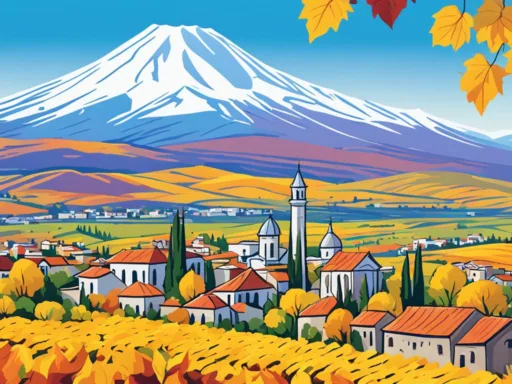Unveiling the layers of a destination’s climate can be as complex and intriguing as understanding its history and culture. When planning the best time to visit Chad, you may find yourself pondering the interplay between weather patterns and human activity. This is particularly true for the Republic of Chad, a land where the environment dictates not only the rhythm of daily life but also the pulse of tourism. In the heart of Central Africa, Chad’s climate is a story of resilience and adaptation—a narrative that’s increasingly shaped by the aridification of its landscapes.
For those World explorers crafting their Chad vacation guide, attention to the country’s environmental challenges is essential. With the “Chad National Adaptation Plan Advancement Project” progressing, this nation is on a steadfast mission to weave climate change adaptation into its very fabric. Discovering Chad is hence not just about embracing its natural beauty and cultural opulence; it’s also about recognizing and respecting its journey towards sustainable growth.
As the seasons turn, each cycle brings a different aspect of Chad to life, whether it’s traditional festivities brimming with color and cultural significance or the stark beauty of a landscape shaped by the elements. This guide illuminates the intersection where the best times to visit coincide with the brightest displays of Chadian heritage.
Key Takeaways
- Understand the impact of climate on planning your visit to Chad—awareness leads to better travel experiences.
- Learn how Chad’s strategies for climate resilience can influence and enhance your travel itinerary.
- Gain insights into the most favorable travel seasons to enjoy Chad’s remarkable cultural events.
- Explore how environmental factors like aridification shape not only Chad’s climate but its cultural tapestry as well.
- Be informed about the uniqueness of Chad’s bioclimatic zones, and how they can affect your vacation planning.
Exploring Chad’s Seasonal Climate
Chad, with its diverse topography and varying climate zones, presents travelers with unique challenges and opportunities for exploration. To best prepare for a visit, one must consider Chad’s weather seasons, which play a pivotal role in determining the most opportune time for travel. Crafting an itinerary that takes into account the regional differences and seasonal patterns not only enhances the experience but is also essential for responsible and sustainable tourism.
Understanding Chad’s Weather Seasons
The vast and varied land of Chad is characterized by distinct seasonal changes that can impact travel plans significantly. Knowing about the Chad weather seasons helps in scheduling visits to catch the country at its best. Typically, the cooler and drier months are touted as the Best Time to Visit Chad, offering a reprieve from the heat and an easier journey across its landscapes.
In the northern Saharan zone, scarce rainfall and soaring temperatures dominate, while the southern Sudanian zone offers a more temperate climate with higher precipitation levels, which can reach 800 to 1200 mm annually. Understanding this variance is among the crucial Chad travel tips that can ensure a remarkable holiday experience.
Adapting to the Sahelian and Sudanian Zones
When mapping out your Chad holiday planning, consider the central Sahelian and the fertile Sudanian zones. Historical data reveals upward trends in rainfall for the Sahelian zone and an ecosystem that supports over half of Chad’s populace. Meanwhile, the Sudanian zone boasts a more humid environment, propelling the nation’s agricultural pursuits. Awareness of these, including the encroaching desertification, affords travelers the insights needed for effective Chad itinerary tips.
| Climate Zone | Rainfall | Temperature | Travel Considerations |
|---|---|---|---|
| Sahelian | Increasing trends | Variable, often high | Cultural and ecological tourism suitability |
| Sudanian | 800 – 1200 mm annually | Mild to warm | Agriculture-based tourism opportunities |
Integrating these factors into your Chad tourism advice ensures a well-prepared and enriching travel experience. With a landscape that shifts with the weather, visitors to Chad are afforded a multilayered journey through this Central African jewel.
Experience the Best Time to Visit Chad
Delving into the heart of Africa, Chad offers visitors a tapestry of landscapes and cultural experiences, but timing your journey is essential for an enriching adventure. With the best time to visit Chad generally falling between November and May, travelers can ideally evade the challenges of the rainy season, which often complicates transportation and accessibility to the country’s remarkable attractions.

Diving deeper into these months, here is a breakdown of how you can capitalize on the very best Chad has to offer while following expert Chad travel tips and sound Chad tourism advice:
- November to February: This is the peak travel season in Chad, with cooler temperatures and minimal rainfall. The Sahara Desert is more hospitable during this time, and the vibrant cultural life of Chad’s urban areas, including the capital, N’Djamena, comes to life.
- March to May: As the heat begins to build up before the arrival of the rains, these months offer a unique opportunity to experience Chad’s bustling marketplaces and the beginning of several cultural festivities.
Keep in mind that Chad’s climatic conditions are not entirely predictable, given the impacts of climate change. Thus, it is advisable to monitor weather forecasts and seek up-to-date Chad travel tips in the lead-up to your trip. Observing these travel considerations ensures that your expedition through the diverse terrains of Chad, from desert oases to lively urban centers, is carried out with ease and enjoyment.
Chad’s Cultural Highlights: Festivities and Traditions
When it comes to Discovering Chad, venturing beyond the breathtaking landscapes and into the realm of vibrant festivals is a must. The country’s capital, N’Djamena, not only functions as a political hub but also stands as the beating heart of Chad’s cultural tapestry. Here, visitors can plunge into a sea of music, dance, and artistic expression that encapsulates the essence of this storied land.
N’Djamena’s International Music Festival
In the urban sprawl of N’Djamena, the International Music Festival emerges as a cornerstone among Chad cultural events. Annually drawing in a crowd that’s as diverse as the performances on stage, the festival serves as a melting pot where traditional rhythms meet contemporary beats. This event acts as a showcase of unity and artistic diversity, offering a prime experience for those seeking true cultural immersion. Whether you’re crafting your Chad vacation guide or simply eager to engage with local customs, the inclusion of this festival will undoubtedly be a highlight.
Gerewol Festival: A Colorful Nomadic Celebration
Another gem in the tapestry of Chad cultural highlights is the Gerewol Festival. As an event deeply ingrained in the nomadic traditions of the Wodaabe community, it’s a spectacle of courtship, beauty, and endurance. The festival’s allure not only lies in its vibrant splendor—alive with colorful garb and spirited dances—but also in its embodiment of endearing cultural practices. For those with a craving for unique experiences in Chad, aligning Chad travel tips with the timeline of Gerewol could mean witnessing an enchanting cultural phenomenon.
Discovering Chad is not merely about traversing the land but also about embracing its soul. The cultural festivities of Chad paint a picture of its rich heritage and community. In these celebrations, the spirit of this African nation is on full display, offering travelers unforgettable memories and stories to cherish.
Wildlife Encounters: Best Seasons for National Parks
For nature enthusiasts seeking an unforgettable safari experience, Chad emerges as an extraordinary destination. The country’s distinct bioclimatic zones harbor some of the most enchanting national parks, brimming with diverse wildlife. If your passion lies in witnessing nature’s marvels in their purest form, timing your visit during the dry season is pivotal. This period, typically stretching from December to April, is when thirsty wildlife frequents watering holes, offering spectacular viewing opportunities. For practical Chad tourism advice, adapt your Chad itinerary tips to include these prime wildlife-watching months for an optimal experience.
Zakouma National Park, a haven for wildlife, becomes a bustling stage showcasing nature’s drama as the dry season peaks. Embark on a journey to this sanctuary to observe herds of elephants, regal giraffes, and majestic lions. The scarcity of water during these months transforms the landscape into a wildlife enthusiast’s dream, presenting unparalleled opportunities for wildlife encounters in Chad. Visitors are encouraged to schedule their trips to coincide with this season, ensuring a front-row seat to the awe-inspiring sights of Chad’s majestic animals in their natural habitat.
As a traveler dedicated to embracing the raw beauty of Africa’s wilderness, aligning your visit with the optimal seasons ensures a profound connection with nature’s rhythms. Whether you are an amateur photographer yearning to capture the serenity of the animal kingdom or a seasoned safari-goer eager for your next thrilling adventure, Chad’s national parks are a testament to the wonders of the wild, awaiting your discovery during these key dry months. Prepare to be immersed in a world where every turn is a page in the grand narrative of Africa’s wildlife.






